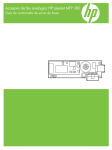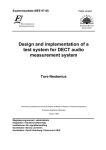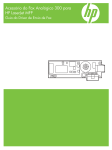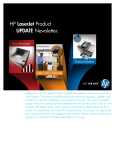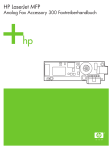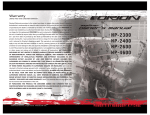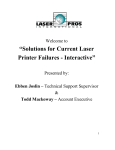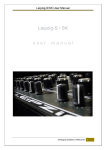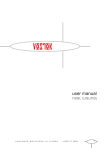Download Solving the Mystery of the HP LaserJet 2400 and
Transcript
We recently received a service call regarding a P3005 with the dreaded symptom of a “loud grinding noise while printing.” Adding even more pressure was that the service call would involve substantial travel. As we tried to get our service strategy together, we looked back over the POD Tech Tips from May 08 articles on the 2400 grinding problem. (Similar gear drive train to the P3005).At that time Parts on Demand put together a “noisy gear kit” (RU5-2400). Over the last few months we have sold a lot of these kits, to resolve the noise problem. We followed up the original article which just covered a temporary fix, with an update, but this was never sent to everyone, only those who had problems at the time. Reprintered in this Tech Tips is this updated article with amendments for the P3005. Even though it has been correctly stated from different sources that the P3005 20T gear had been redesigned, (from the HP2400) a new 20T gear was installed (our experimentation on a P3005 had shown that changing out the entire inner chassis drive train took major time, and made absolutely no difference]. We had found that the service manual was not an entirely accurate representation of the fuser drive gears. Fortunately, the Engineer in the field found that the removal of the parts was similar enough to the POD Tech Tips HP LaserJet 2400 Grinding Part II article, Figure 1, that the removal of the 20T gear was not that difficult. The new 20T gear was installed and the unit was put back together. The power was applied. At first, the Initial Rotation was so quiet that it seemed possible that something was wrong. There was almost no noise and possibly the gear train was not even completely engaged. The unit did come Ready, and with apprehension (every Engineer knows that feeling], the unit was tested. The Pick was clean, the Exit was solid, and the print was excellent. Amazingly, the grinding noise completely disappeared. The unit was actually quieter than any new P3005 chassis that has been observed! To sum up, even though it has been correctly stated that the 20T gear in the P3005 was redesigned, a new 20T gear, (RU5-0957] saved that service call. It was then felt that it was worthwhile republishing the original article, for this month’s Tech Tips. 1 Solving the Mystery of the HP LaserJet 2400 and P3005 Grinding Noise In the May 08 issue of POD Tech Tips, we described a temporary solution to reduce the grinding noise related to the HP 2400 fuser. In this article, we offer even more options. But we've heard from techs that there are actually some new noises coming from a completely different location: near the delivery drive assembly and duplex and gearing system. We'll offer solutions to address this new noise as well. Grinding Noise from the Fuser In Part 1, we found that placing a spacer washer between the fuser and chassis on the bottom gear side of the fuser reduced or eliminated the grinding noise. Since the May article, we've had some good input from techs in the field. One noted a common problem with the bushing on the lower pressure roller. This bushing allowed the lower pressure roller to wander slightly from side to side. The movement did two things. First, it wore away at that bushing which would cause the fuser drive gear to change its angle in relation to the fuser drive gear in the printer (spur gears trying to mesh with a now semi- helical gear is not a good thing). Second, the wandering lower pressure roller would allow the drive gear on the fuser to chip away at the larger of the double set of drive gears in the fuser, as we discussed in the May article and thus the noise. The spacer washer was more of a temporary solution that moves the fuser and the gear, eliminating the grinding noise. The actual solution to the noise is the replacement of the fuser when the grinding occurs as the lower pressure roller bushing is on its way out. If left that way, the bushing has been known to completely deteriorate. Now the good news. With the identification of the bushing problem, Parts on Demand has acquired an improved bushing that prevents the wandering lower pressure roller. Each fuser we rebuild has this upgrade which means these Figure 1 fusers will run to their full life expectancies and you won't have to deal with this noise issue going forward. While the fuser fixes one growling noise, another buzzing noise is caused by parts inside the printer. Studying the noise issue and trying to recreate it, we discovered an interesting set of drive gears that helped us ultimately figure out the solution. The two drives and their motor do three things: Drive the fuser at normal speed via the main motor Drive the fuser and delivery via the fuser motor at a higher speed Drive the delivery in reverse and engage the fuser when in duplex mode What's interesting is the fuser is being driven by two motors which can run at two different speeds and in opposite directions. Let's take a closer look using figure L. Note the fuser drive gear or LPR (Lower Pressure Roller) gear, is driven by two sets of gears, both "A" and "C". Gear "C" is driven by the main drive motor which also turns the pickup, registration, toner cartridge, transfer and duplex sections in the front. The fuser is driven by the main drive motor and also by the fuser motor. You would think they would fight each other, but they don't. They're designed to work this way. It makes more sense when we look at the running process. When the printer first starts up, the fuser motor is not running even though the main drive motor has kicked in, turning the pickup, registration, toner cartridges and transfer and duplex sections in the front. The main drive motor is being driven via gear "C" on the bottom. A couple of seconds later, the fuser motor kicks in and runs at a higher speed, engaging gear "A". This turns the fuser at a higher speed than the main drive. The gear below gear "C" has a spring clutch on it which allows it to turn at the higher speed without fighting against the other gears. Thus, when the fuser rotates faster than the main drive, the spring clutch allows gear "C" to rotate faster than the main drive without a fight. driven by the gear on top of the fuser instead of by gear "A". The question now is does the fuser rotate in reverse since the fuser motor is now in reverse? The answer is no. The gearing is set so the fuser is always rotating forward, which makes sense. It seems it’s hard enough to make the fusing film system work running one direction, to run it in two directions is only asking for trouble. So why does the fuser run during the duplex process? The fuser delivery rollers are used to help guide the reversed paper into the duplex section of the printer. Without the help of the fuser we greatly increase the risk of a paper jam getting paper to the duplex. An important function of the printer is the swing gear which you've been hearing about and may be wondering how it swings to the right gear. The break is the metal clip on the top of the plastic arm. This causes the arm to rotate in the direction that the gear is rotating to engage different In duplex mode, the delivery rollers rotate in reverse, as the fuser motor is running in reverse, and pulls the paper back into the printer. The swing gear then engages gear "B" due to the rotation of the gear above it and the fuser is Figure 2 gears. In figure 2, you can see the swing gear along with its drive gears that hook up with the fuser motor. You can see a metal clip on the plastic arm of this assembly. This is actually a "break" that causes the arm to move in the direction of the gear above it. The "break", much like the pinching effect of a bicycle brake on the rim, creates enough friction that the swing arm follows the rotation of the gear above it. 1f the swing gear's drive gear powered by the fuser motor is rotating in print mode, the swing gear moves toward a gear "A". When duplexing, the fuser motor runs in the opposite direction moving the swing gear to gear "B". When the main motor is driving the fuser, the swing gear kicks into neutral so the fuser motor is not being turned unpowered. In trouble-shooting the noise problem, we experimented by removing gear "B" to see if the machine would still duplex. Interestingly enough, without the gear, the duplex and fuser still worked. The fuser was being driven solely by the main drive. Could it be the only need for gear "B" and the redundant drive is to "help" turn the fuser? The answer must be yes, since removing that gear made no difference. We also noticed a chatter with the gear missing but that was due to the swing gear contacting the bare shaft where gear "B" had been. The chatter feeds into a theory our tech support department has surrounding the delivery noise. Their theory points to two areas. First is the grease on the gears inside the delivery assembly and fuser motor area. The grease has been known to dry over time (or perhaps better put, gum up from paper and toner dust) which keeps the swing gear from properly engaging with gears "A" and "B". The second is the "brake" on the swing arm may become less effective over time, thus the swing gear may not fully engage with gears "A" and/or "B". Both scenarios would cause a buzz like noise if the gears are only partially engaged. The fuser would still turn via the main drive assembly so no paper jam, just noise. 1n studying this swing gear, we noticed the P3005 (replacement for the HP2400) has a coil spring as the "brake" instead of the bicycle type brake. Either one would cause the swing gear to swing with the turning of its drive gear. A weak brake however could be our buzzing culprit. The bad Figure 3 news is, to get at the delivery gears and the break on the swing arm, the printer needs to be torn down to a large extent. This means removing all main unit covers, the fuser, formatter, engine controller and fan, un-routing cables near the delivery assemble, and partially splitting the chassis left to right to remove it and get at the gears for cleaning. Is there an easier solution to this noise issue? As we were working on this, a customer contacted us after reading the first article on the HP2400. He had replaced the fuser and was not successful in using the spacer washers. In the interests of sharing the knowledge, the customer shipped us the printer so we could learn from it and return it to them with a free repair. This repair definitely shed light on the noise problem. This service company said their customer didn't use the printer in the office because it was so loud when printing that you couldn't talk on the phone, yes, that loud. What we found was simple, but not some place you would look if you were trying to find the cause. It all goes back to the drives we were discussing earlier. We noticed the noise did not start when the printer turned over. Instead it waited a couple seconds after the main drive motor started up, sound familiar? The sound corresponds with the engagement of the delivery rollers and the fusing motor. Could it be a bad delivery assembly? Searching further we were surprised to see the 20 tooth gear that drives the fuser was worn. The wear corresponded perfectly with the size of the teeth on the fuser gear. It appears that the stress of turning the fuser at the higher speed was causing the 20 tooth gear to wear out (letter “d” in Figure 1.) This was easy to trouble- shoot as we replaced the gear with a good one and the noise went away. We put the bad gear into our HP 2400 printer which duplicated the noise exactly. So what was going on and why was the spacer washer fixing some of these but not this one? Looking at the gears and how they mesh it is apparent the wear in the 20 tooth gear cut steps into its teeth. As the gears would turn from the torque, the fuser teeth would first encounter that step in the 20 tooth gear and push the fuser away from it. Note the cut marks in the teeth of the 20 tooth gear FIGURE 4: This would be followed by it slipping into its proper mesh as it turned. As each of the teeth did this, a loud buzzing sound Figure 4 would result. This is diagrammed in figure 3. The part number for the 20 tooth gear is RU5-0378-000. 1t was interesting to look up this part in our ordering system to see we've sold a lot of these gears. That's more than twice as many as the other gears in that area. As a tech, it may be wise to inspect the other gears “A", "B" and swing gear for damage. However as the 20 tooth gear was badly chewed up we saw no damage to the others so it looks like the solution is just the 20 tooth gear. This is easy to replace by bending out the clip that holds it in place and sliding it off the shaft. The part numbers for the other gears, should you need them are: RU5-0379-000 L9 tooth gear RU5-0377-000 28 tooth gear The swing gear along with the gears in the delivery assembly area is not available thus the suggestion is to clean and re-lube if you need to do anything with them. This also brings another question to mind. As noted in the last article, the ` P3005, ` M3027mfp and ` M3035mfp all use the same type of drive assembly for the fuser. However in closer study, the problem may be averted for them. These machines use beefed-up gears and they are also using helical gears instead of spur gears in the HP 2400. The helical gears will hopefully keep this from happening in the newer units. We consider it a clue when the OEM beefs up certain areas of the printer that replaced the prior model. It tells us they saw a weak spot that needed to be addressed: thus another indicator that the gear solution is the right one. Another clue is the delivery gears (as mentioned earlier) are not available on the HP 2400 printers, but are available on the P3005, M3027mfp and M3035mfp units. This indicates the likelihood that the unavailable gears in the HP 2400 may be a problem as well. HP's current solution for fixing HP 2400 problems that have expensive or non- obtainable parts is a unit exchange. While the fuser and 20 tooth gear are good finds in a world flooded with models that we all need to somehow be experts on, we question whether this will be the end of the story. Like the HP 4000 series that had multiple paper-jam related problems in the front part of the unit. We believe we'll find more issues and solutions as these printer ages. This is why it is so important to get feedback from the engineers in the field that we can then relay on for the benefit of everyone. Parts on Demand would like to thank every one of our customers for contributing to this article in one form or another 6






